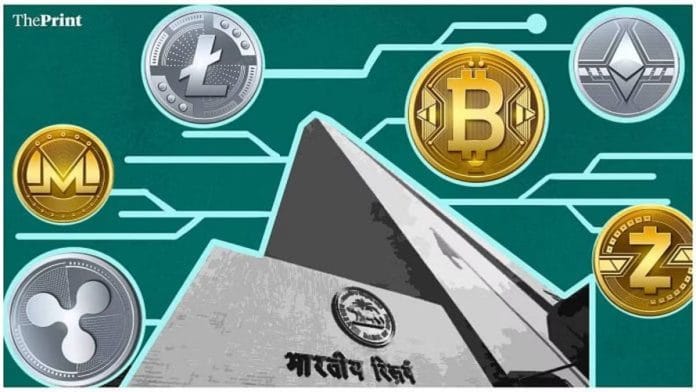New Delhi: The Indian government has lost out on collecting over Rs 6,000 crore in tax revenue on Virtual Digital Assets (VDAs)—another name for cryptocurrencies—since July 2022, according to a report by Esya Centre, a New Delhi-based technology think tank.
Over the next five years, the government could lose out on an additional Rs 17,700 crore in tax revenue, it added. This has largely been driven by a shift in trading activity and user assets to offshore platforms, largely to avoid the compliance burden placed on Indian users.
The report, released Friday, examined the impact of both capital gains tax and tax deducted at source (TDS) on VDA transactions.
The government implemented a 30 percent capital gains tax on cryptocurrencies and other digital assets from 1 April, 2022. Notably, this tax did not allow users to offset the losses they made in crypto transactions against their profits.
Additionally, a 1 percent TDS on VDA transactions exceeding Rs 10,000 came into effect on 1 July, 2022.
In addition to the tax policies, the study also measured the efficacy of regulatory measures.
These include the inclusion of VDAs and VDA service providers under the Prevention of Money Laundering Act (PMLA), and the blocking of URLs of nine non-compliant foreign VDA exchanges by the Financial Intelligence Unit (FIU).
Although both the tax policies and regulations were meant to enhance transparency and strengthen regulatory oversight, the effectiveness has been limited, the report noted.
Also Read: Unemotional, faster & more secure — AI has many benefits for crypto, but don’t trust it blindly
Limited TDS collections
The report found that, between July 2022 and December 2023, Indians traded more than Rs 1.03 lakh crore worth of VDAs on platforms that did not comply with the TDS regulations, with only about 9 percent of total holdings on domestic exchanges.
Between December 2023 and October 2024, Indians traded over Rs 2.63 lakh crore on offshore platforms—including the nine blocked exchanges—accounting for over 60 percent of the trading volume.
Policies like URL blocking have proven to be inadequate as users have found ways to circumvent these restrictions, including using Virtual Private Networks (VPNs), the report noted, adding that some foreign exchanges are attempting to comply with Indian regulations, but TDS collections are either non-existent or limited.
Binance, a global cryptocurrency exchange, is registered with the FIU but had not initiated TDS deductions at the time the report was published, the authors noted.
KuCoin, a Singapore-based exchange, registered with the FIU through a local entity, began deducting TDS in March 2024 but accounts for less than 5 percent of total offshore trading by Indians.
While domestic exchanges generated Rs 366 crore in TDS from January to October 2024, long-term trends indicate more Indian users moving to offshore platforms. For example, web traffic to domestic platforms such as CoinDCX and WazirX has declined by 34 percent since the beginning of the year, according to the report.
Additionally, there has been a 30 percent reduction in domestic peer-to-peer advertisers, a system where users directly create listings on trading platforms for buying or selling VDAs directly from other users, it said.
Reforming India’s VDA landscape
Based on current trends, Indians will trade a total of Rs 17.7 lakh crore worth of VDAs on offshore platforms over the next five years, resulting in Rs 17,700 crore in uncollected TDS.
To combat the loss of tax revenue and restore the competitiveness of domestic exchanges, the report underscored an urgent need for revising India’s VDA tax policy.
First, it emphasised the need for amendments to the existing tax legislation. Mandating offshore platforms comply with local tax laws—irrespective of their physical presence in the country—would ensure broader compliance and accountability, the report said.
Also, exchanges would need to be defined as “persons responsible” for deducting TDS on VDA transactions, even if they do not directly handle payments.
The report also advocated for allowing loss setoffs against gains from other VDA trades and the ability to carry forward unutilised losses to subsequent financial years.
A reduction in the TDS rate to 0.01 percent was also proposed, more in line with other comparable asset classes such as securities and commodities.
In a scenario where TDS is at this revised percentage and share of assets held on domestic platforms reverts to pre-February 2022 levels, an estimated 82 percent of Indian users would trade through domestic or compliant platforms, the report said. This, it added, could generate up to Rs 18,300 crore in tax revenue over five years.
The report highlighted that India ranked first in grassroots VDA adoption, but the current regulatory framework “disproportionately affects compliant users”.
The current limitations have resulted in substantial uncollected tax revenue while also incentivising users to evade regulations. To mitigate these losses, a reduction in TDS along with changes in compliance are both required, it said.
(Edited by Nida Fatima Siddiqui)
Also Read: Indians have two attitudes towards cryptocurrency – deep suspicion or blind hero-worship






